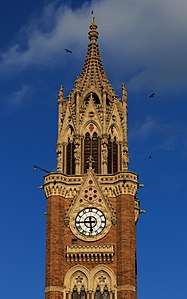University of Mumbai
|
Mumbaī Vidyapīṭha | |
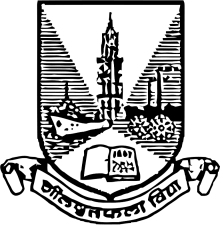 | |
Former names | University of Bombay |
|---|---|
| Type | Public |
| Established | 18 July 1857 |
| Founder | John Wilson |
| Chancellor | Governor of Maharashtra |
| Vice-Chancellor | Suhas Pednekar[1] |
| Location |
Mumbai, Maharashtra, India 18°58′30″N 72°49′33″E / 18.97500°N 72.82583°ECoordinates: 18°58′30″N 72°49′33″E / 18.97500°N 72.82583°E |
| Campus | Urban |
| Colors | Blue |
| Affiliations | UGC, NAAC, AIU |
| Website |
mu |
The University of Mumbai, informally known as(MU), is one of the earliest state universities in India and the oldest in Maharashtra.
The University of Mumbai offers Bachelors, Masters and Doctoral courses, as well as diplomas and certificates in many disciplines. In University many course are available B.a,B.com,B.sc medical AMD engineering.The language of instruction for most courses is English. The University of Mumbai has three campuses across Mumbai (Kalina Campus, Thane Sub Campus and Fort Campus) and one outside Mumbai. The Fort campus carries out administrative work only. Several institutes in Mumbai previously affiliated to the university are now autonomous institutes or universities. The University of Mumbai is one of the largest universities in the world. In 2011, the total number of enrolled students was 549,432.[2] The University of Mumbai currently has 711 affiliated colleges.[3]
History
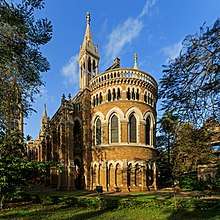
In accordance with "Wood's despatch", drafted by Sir Charles Wood in 1854, The University of Bombay was established in 1857 after presentation of a petition from the Bombay Association to the British colonial government in India.[4] The University of Mumbai was modeled on similar universities in the United Kingdom, specifically the University of London.[4]:188
The first departments established were the Faculty of Arts at Elphinstone College in 1835 and the Faculty of Medicine at Grant Medical College in 1845.[4] Both colleges existed before the university was founded and surrendered their degree-granting privileges to the university. The first degrees awarded in 1862 were Bachelor of Arts and Licentiate in Medicine.[4]
Initially, the Town Hall in Mumbai was used as the university's offices.
Until 1904, the university only conducted examinations, awarded affiliations to colleges, developed curricula and produced guidelines for colleges developing curricula.[4] Teaching departments, research disciplines and post-graduate courses were introduced from 1904 and several additional departments were established. After India achieved independence in 1947, the functions and powers of the university were re-organised under The Bombay University Act of 1953. [5] The name of the University was changed from University of Bombay to University of Mumbai in 1996.[6]
In 1949, student enrollment was 42,272 with 80 affiliated colleges. By 1975, these numbers had grown to 156,190 and 114 respectively.[4]
Campuses
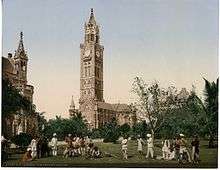
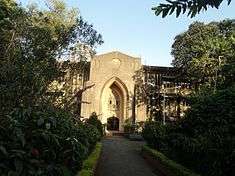
Kalina Campus
The Kalina campus in suburban Mumbai covers an area of 93 hectares (230 acres) and houses graduate training and research centres. Departments offering courses in the sciences, technology, commerce, and humanities are located here. Most colleges of engineering and medicine affiliated to the University of Mumbai, though, are privately owned. The university does not have its own engineering or medicine departments.
Centres and institutes located in the Kalina Campus include:
- Examination House, also known as Mahatma Jyotirao Phule Bhavan houses the office of the Controller of Examinations. Centralized assessment of answer books for various departments is carried out in a separate four-storey annex. Examination processes were made more efficient by the introduction of online delivery of question papers for examinations, and assessment of answer books by scanning at remote examination centres. The academic depository of the university was started in collaboration with CDSL in 2015. The university is the first university in the country to start an academic depository. [7]
- National Centre for Nanosciences and Nanotechnology — a research facility
- Department of Biophysics — the only such department in western India
- Jawaharlal Nehru Library
- Garware Institute of Career Education and Development, whose courses include medical transcription and management courses such as agriculture business management, pharma management and tourism management
- MAST (मस्त) FM, the campus radio station of the university operating at 107.8 MHz frequency modulation
- Alkesh Dinesh Mody Numismatic Museum which houses displays of currency from around the world
- Alkesh Dinesh Mody Institute for Financial and Management Studies (ADMI) which offers BMS, MFSM and MMS programmes[8]
- Department of Extra Mural Studies which conducts weekend courses in many disciples including astronomy, astrophysics, plant and animal taxonomy, hobby robotics, and hobby electronics
- The Institute of Distance and Open Learning (IDOL) which offers courses in humanities, sciences, commerce, computer science, and information technology
- Western Regional Instrumentation Centre (WRIC) — a research and training facility for instrumentation engineering and science
- Centre for African Studies
- Centre for Eurasian Studies
- A rose garden where more than a hundred varieties of rose have been cultivated
- Marathi Bhasha Bhavan Centre which conducts academic and cultural activities associated with the Marathi language
Thane Campus
The Thane Campus, established in 2014, spans an area of 2.4 ha (6 acres) and is a modern, two-storey complex. It houses administrative offices, the School of Law, University of Mumbai and also undertakes management courses.
Fort Campus
The University of Bombay was established in 1857 at the Fort campus, which is located near the southern end of Mumbai island. It houses the administrative division of the university on a 5.3 ha (13 acres) site. It has 116,000 m2 (1.25×106 sq ft) of built-up area, 2,000 m2 (22,000 sq ft) of classrooms, and 7,800 m2 (84,000 sq ft) of laboratory space. There are two post-graduate centres, 354 affiliated colleges, and 36 departments. It is built in the Gothic style and the Rajabai Clock Tower stands on the lawns of the campus.
Rajabai Clock Tower
One of Mumbai's landmarks, the Rajabai Clock Tower was completed in the 1870s and houses the University of Mumbai's library. Sir George Gilbert Scott modeled the Rajabai Clock Tower on the clock tower of the Palace of Westminster in London.[9] Local businessman Premchand Roychand contributed to the cost of construction and named the tower in memory of his mother, Rajabai. The tower is 85 m (280 ft) tall and has five storeys. At a height of 9.1 m (30 ft) from the ground, there are eight statues representing the Indian castes. The tower clock is reported to have played 16 tunes including Rule, Britannia. On the initiative of the then Vice-Chancellor, Dr. Rajan Welukar, the first phase of restoration of Rajabai Clock Tower started in 2013 and was completed in May 2015. Tata Consultancy Services (TCS) gave a Rs 4 crore grant for this phase of the restoration project.[10]
Ratnagiri Campus
This minor campus, running mostly extramural courses, is located in the town of Ratnagiri.
Prominent institutes
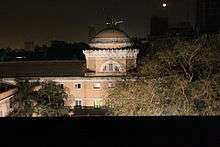
Several departments of the University of Mumbai are located away from the three Mumbai campuses. These include the departments of Medicine and Medical Research located in several prominent hospitals in Mumbai, such as the Tata Memorial Hospital, Bombay Hospital and G.S. Medical College and King Edward Memorial Hospital. The Institute of Chemical Technology, then known as the UDCT, was originally an institution of MU, but later gained university status.[11] Tata Memorial Hospital is now affiliated to the Homi Bhabha National Institute.
Similarly, Veermata Jijabai Technological Institute was the first Engineering Institute in the University of Mumbai (1887)[12] and Thadomal Shahani Engineering College was the first Engineering college in the University of Mumbai to start courses in Computer Engineering, Information Technology, Electronics Engineering and Biomedical Engineering. Sardar Patel College of Engineering is another engineering college affiliated to the University .[13]. Further, K.J. Somaiya College of Engineering is additional engineering college affiliated to the University.
The Jamnalal Bajaj Institute of Management Studies was established in 1965 in collaboration with Stanford Graduate School of Business of Stanford University. Sophia College for Women was established in 1941.
Libraries

Jawaharlal Nehru Library (JNL) is the central library, located on the campus at Kalina.
The technology and applied research journals and books of the University of Mumbai are kept in the libraries of the Institute of Chemical Technology, Tata Institute of Fundamental Research, Jamnalal Bajaj Institute of Management Studies and Tata Memorial Hospital.
Faculties and departments
The University of Mumbai has several hundred affiliated colleges offering undergraduate and post-graduate education, and conducting research in areas of science, commerce, arts, engineering, management, law, etc. Each college has its own campus and specialized departments/centres.
Areas of education and research are summarized in the table below:
| Faculty | Departments / Centres / Institutes |
|---|---|
| Management[14] |
|
| Arts[15] |
|
| Social Science |
|
| Commerce[16] |
|
| Law[17] |
|
| Science[18] |
|
| Engineering / Technology |
|
| Sports[19] |
|
| Institutes and centers[20] |
|
Vice-Chancellors
- John Wilson – 1857
- Raymond West
- Alexander Kinloch Forbes
- Sir Alexander Grant, 10th Baronet – 1863–1868
- William Guyer Hunter – 1869
- Herbert Mills Birdwood
- Rev Dugald Mackichan – 1888-91
- Kashinath Trimbak Telang – 1892–1893
- Ramkrishna Gopal Bhandarkar – 1893–1894
- N. G. Chandavarkar – 1911−1912
- John Heaton – 1912–1915
- Pherozeshah Mehta – 1915
- Sir Leslie Orme Wilson (Chancellor) - 1927
- Mirza Akbar Khan – 1930–31
- R. P. Paranjpe – 1934
- Sir Rustom Pestonji Masani - 1941
- Pandurang Vaman Kane
- John Matthai – 1955–1957
- V. R. Khanolkar – 1960–1963
- Shashikant Karnik
- Trimbak Krishna Tope – 1971–1977
- M. D. Bengalee – 1986
- Snehalata Deshmukh – −2000
- Bhalchandra Mungekar – 2000–2005
- Vijay Khole – 2005 – September 2009
- Chandra Krishnamurthy – September 2009–July 2010, Acting Vice-Chancellor
- Rajan Welukar – July 2010 – July 2015
- Sanjay V. Deshmukh – July 2015 – October 2017 [21]
- Dr. Suhas Pednekar - April 2018 − Present
Ranking
| University and college rankings | |
|---|---|
| General – international | |
| QS (World) (2018)[22] | 801–1000 |
| QS (BRICS) (2018)[23] | 82 |
| QS (Asia) (2018)[24] | 181 |
| General – India | |
| NIRF (Universities) (2018)[25] | 151–200 |
Internationally, the University of Mumbai ranked 801–1000 by the QS World University Rankings of 2018,[22] 181 in Asia[24] and 82 among BRICS nations.[23]
The National Institutional Ranking Framework (NIEF) ranked it in the 151–200 band among universities in India in 2018.[25]
Notable alumni
Politics and public life
- B. R. Ambedkar – founding father of modern India, champion of human rights, author of the Constitution of India, social reformist and polymath
- Muhammad Ali Jinnah – founder and Father of the Nation of Pakistan
- Bhulabhai Desai – Indian independence activist and acclaimed lawyer
- Dadabhai Naoroji – intellectual, educator, cotton trader, and an early Indian political leader; the first Asian to sit in the British House of Commons
- Gopal Krishna Gokhale, CIE – social and political leader during the Indian Independence Movement
- John Samuel Malecela – 6th Prime Minister of Tanzania, 1990–1994
- Kona Prabhakara Rao – State Governor of Maharashtra, Pondicherry and Sikkim; Finance Minister of Andhra Pradesh; former speaker of Andhra Pradesh State Assembly
- Lal Krishna Advani – former Deputy Prime Minister of India
- Lokmanya Tilak – Nationalist leader, savant, philosopher, mathematician, and advocate of Swaraj (self-rule)
- Mahadev Govind Ranade – distinguished scholar, social reformer and author
- Mancherjee Bhownagree – British politician of Indian Parsi heritage.
- Manohar Joshi – former Chief Minister of Maharashtra
- Sir Manubhai Mehta – Dewan of Baroda state; Prime Minister of Bikaner state
- Morarji Desai – 5th Prime Minister of India
- Nilesh Rane – MP from Ratnagiri-Sindhudurg
- Sir Pherozeshah Mehta, KCIE – Indian political leader, activist, and an erstwhile leading lawyer in Mumbai
- Praful Patel – MP from Bhandara-Gondiya
- Pratibha Patil – 12th President of India
- Rafiq Zakaria – politician and Islamic scholar
- Raj Thackeray – founder, leader and chairperson of the Maharashtra Navnirman Sena
- Sanjay Dina Patil – MP from Mumbai North East
- Sanjeev Naik – MP from Thane.
- Shivraj Patil – Governor of Punjab and former Home Minister of India
- Sushilkumar Shinde – former Home Minister of India
- Swati Dandekar – Member of the Iowa House of Representatives
- Vasundhara Raje – Chief Minister of Rajasthan, India
- Yashwantrao Chavan – 1st Chief Minister of Maharashtra; 5th Deputy Prime Minister of India
- Chintaman Dwarakanath Deshmukh, CIE, ICS – 3rd Governor of the Reserve Bank of India
- Shanti Gandhi – US politician and physician
- Kshama Sawant – member of the Seattle City Council (2014-present)
Science
- Shreeram Shankar Abhyankar – Indian American mathematician known for his contributions to algebraic geometry, and former Marshall Professor and chair of mathematics at Purdue University
- Edward Hamilton Aitken – humorist, naturalist
- Salim Ali – Indian ornithologist and naturalist
- Mustansir Barma – Director of Tata Institute of Fundamental Research
- John Barnabas – evolutionary biologist, Shanti Swarup Bhatnagar Prize (1974)[26]
- Sekhar Basu – Chairman of the Atomic Energy Commission of India
- Homi Jahangir Bhabha, F.R.S. – nuclear physicist who played a major role in the development of India's atomic energy programme
- Renee M. Borges – ecologist
- Amol Dighe – professor of physics in Tata Institute of Fundamental Research
- Madhav Gadgil – ecologist and professor at Indian Institute of Science
- Ravi Gomatam – quantum physicist, director of Bhaktivedanta Institute
- Vijay Gupchup – former Pro-Vice-Chancellor of the University of Mumbai, ex-chairman of the Research Council of Structural Engineering Research Centre in Chennai and ex-chairman of the National Board of Accreditation of AICTE
- Jyeshtharaj Joshi – Indian chemical engineer and nuclear scientist, emeritus professor at Department of Atomic Energy
- Anil Kakodkar – former director of BARC, Chairman of the Atomic Energy Commission and Secretary to the Government of India Department of Atomic Energy
- Vijay Kumar Kapahi – astrophysicist, Shanti Swarup Bhatnagar laureate[27]
- Krishnaswamy Kasturirangan – space scientist and former head of the Indian Space Research Organisation
- Mohammad Ali Reza Khan – wildlife conservationist[28]
- Chandrashekhar Khare – professor of mathematics at the University of California Los Angeles
- Chunni Lal Khetrapal – chemical physicist and Shanti Swarup Bhatnagar laureate[29]
- Gopal Krishna - radio astronomer, Shanti Swarup Bhatnagar laureate[30]
- Sethunathasarma Krishnaswami – geochemist, Shanti Swarup Bhatnagar laureate[31]
- Ashish Kishore Lele – chemical engineer, Shanti Swarup Bhatnagar laureate[32]
- G.S. Maddala – American economist and mathematician
- Raghunath Mashelkar – F.R.S. – former Director General of Council of Scientific and Industrial Research
- Nuggehalli Raghuveer Moudgal – endocrinologist, Shanti Swarup Bhatnagar laureate[33]
- Ramakrishnan Nagaraj – biochemist, Shanti Swarup Bhatnagar laureate[34]
- Mudumbai Seshachalu Narasimhan – F.R.S., mathematician and recipient of Shanti Swarup Bhatnagar Prize (1975)
- Raghavan Narasimhan – mathematician and professor at University of Chicago
- Virendra Nath Pandey – molecular virologist, Shanti Swarup Bhatnagar laureate[35]
- D. Raghavarao – statistician and Laura H. Carnell Professor and chair of statistics at Temple University
- Raja Ramanna – Indian nuclear scientist
- Doraiswami Ramkrishna – Harry Creighton Peffer Distinguished Professor of Chemical Engineering at Purdue University
- Vivek Ranade – chemical engineer, Shanti Swarup Bhatnagar laureate[36]
- E. V. Sampathkumaran - condensed matter physicist, Shanti Swarup Bhatnagar laureate[37]
- N. S. Satya Murthy – physicist, Shanti Swarup Bhatnagar laureate[38]
- Conjeevaram Srirangachari Seshadri, F.R.S. – mathematician and recipient of Shanti Swarup Bhatnagar Prize
- H.N. Sethna – former Chairman, Atomic Energy Commission
- Man Mohan Sharma – F.R.S., former director of UDCT, Padma Vibhushan and Padma Bhushan awardee
- Manil Suri – Indian mathematician and writer
- Bal Dattatreya Tilak – former director of National Chemical Laboratory and recipient of Shanti Swarup Bhatnagar Prize, Padma Bhushan
- Jayant B. Udgaonkar – molecular biologist and Shanti Swarup Bhatnagar laureate[39]
- Acacio Gabriel Viegas – medical practitioner credited with the discovery of the outbreak of bubonic plague in Mumbai, India in 1896
Academia
- Georg Bühler – scholar of ancient Indian languages and law, fellow of University of Mumbai
- Indira Viswanathan Peterson – Professor of Asian Studies and editor of the Norton Anthology of World Masterpieces
- Jagdish Bhagwati – University Professor of Economics at Columbia University
- Avinash Dixit – John J. F. Sherrerd '52 University Professor of Economics Emeritus at Princeton University
- Pandurang Vaman Kane – Indologist and Sanskrit scholar and former Vice-Chancellor of University of Mumbai
- Ramakrishna Gopal Bhandarkar – Oriental scholar and social reformer, first batch graduate, later vice-chancellor
- Homi K. Bhabha – Anne F. Rothenberg Professor of English and American Literature and Language, and director of the Humanities Center, Harvard University
- Klaus Klostermaier, F.R.S.C. – Professor Emeritus at the University of Manitoba, scholar of Indian Studies
- Madhav Das Nalapat – academic, columnist, and UNESCO Peace Chair
- Madhav Sadashiv Gore – Vice-Chancellor of Jawaharlal Nehru University and Padma Bhushan awardee
- Nissim Kanekar, astrophysicist, Shanti Swarup Bhatnagar laureate[40]
Arts
- Anil Kapoor – actor
- Anand Patwardhan – documentary film-maker
- Dadasaheb Phalke – Indian producer-director-screenwriter, known as "the father of Indian cinema"[41]
- Emraan Hashmi – actor
- Ebrahim Alkazi – theatre director, Padma Vibhushan awardee
- Gangadhar Gadgil – author (fiction, Marathi)
- Genelia D'souza – actor
- John Abraham – actor
- Kader Khan – actor
- Kareena Kapoor Khan – actor
- Madhuri Dixit – actor
- Mehli Mehta – conductor of European classical music
- Nissim Ezekiel – poet
- P. L. Deshpande – writer, actor, composer, film and television producer and director
- Ranjan Ghosh – filmmaker and director Aparna Sen's first co-author
- Rohinton Mistry – author
- Sonam Kapoor – actor
- Shabana Azmi – actor
- Smita Patil – actor
- Sonakshi Sinha – actor
- Srinivas – playback singer
- Urmila Matondkar – actor
- Vidya Balan – actor
- Zubin Mehta – conductor of Western classical music
Beauty pageant winners
- Aditi Govitrikar – Mrs. World beauty pageant winner, 2000
- Aishwarya Rai – Miss World 1993 pageant winner, actor
- Lara Dutta – Miss Universe pageant winner, 2000
- Priyanka Chopra – Miss World 2000 pageant winner, actor
Business
- Adi Godrej – Chairman of Godrej Group
- Ajit Gulabchand – industrialist, chairman and managing director Hindustan Construction Company
- Anil Ambani – Chairman of Anil Dhirubhai Ambani Group
- Anji Reddy – founder of Dr. Reddy's Laboratories, Padma Shri awardee
- Avtar Saini – former director for South Asia Region, Intel; one of the pioneers of the Pentium-series processors
- Azim Premji – Chairman of Wipro Limited
- Chanda Kochhar – CEO and MD of ICICI Bank
- Dorabji Tata – former chairman of Tata group
- Jagdish Chandra Mahindra – industrialist, founder of Mahindra Group
- Jamsetji Tata – founder of Tata group and the Indian Institute of Science
- Keki Hormusji Gharda – founder of Gharda Chemicals
- Keki Mistry – Vice-chairman and CEO
- Mukesh Ambani – Chairman and managing director of Reliance Industries
- Narotam Sekhsaria – co-founder and chairman of Ambuja Cements
- Nirmal Jain - founder and chairman of India Infoline (IIFL)[42]
- Nita Ambani – founder and chairperson of the Dhirubhai Ambani International School
- Pankaj Patel – Chairman and managing director of Cadila Healthcare
- Renuka Ramnath – founder and CEO of Multiples Private Equity, ex-CEO of ICICI Ventures
- Tarang Jain - billionaire founder of Varroc[43]
Journalism
- Sucheta Dalal – business journalist
- Samarth Singh – former Times of India writer, foreign affairs blogger, Spain India Council Foundation [44][45]
- Thrity Umrigar – journalist and author
- Homai Vyarawalla – first woman photojounalist of India, Padma Vibushan awardee
Law
- B.N. Srikrishna – Indian jurist and a judge of the Supreme Court of India
- H. J. Kania – first Chief Justice of India
- Kashinath Trimbak Telang – Indian judge and oriental scholar
- M. C. Chagla – Indian jurist, diplomat, former cabinet minister, former Chief Justice of the Bombay High Court
- Mushtak Ali Kazi – Judge of the High Court of Sindh and Balochistan, Pakistan
- Nanabhoy Palkhivala – Indian jurist and economist
- P. N. Bhagwati – Chief Justice of India (1985–1986)
- S. K. Venkataranga – lawyer; an associate of Mahatma Gandhi
Religion
- Virchand Gandhi – Jain scholar and lawyer known for representing Jainism at the first World Parliament of Religions, Chicago 1893
- Zakir Naik - doctor
Sport
- Ajit Agarkar – former cricket player
- Farokh Engineer – former cricket player
- Sunil Gavaskar – former cricket player
- Harish Kapadia – Himalayan mountaineer and recipient of Patron's Medal of the Royal Geographic Society
- Ravi Shastri – former cricket player
Miscellaneous
- Dwarkanath Kotnis – doctor practising in China who helped the Chinese communist army during World War II
- Muffazal Lakdawala – obesity surgeon; laparoscopic expert; founder of the Centre for Obesity and Digestive Surgery
- Anant Pai – publisher of Indian books for children, especially the series Amar Chitra Katha
- Sir Chinubhai Madhowlal Ranchhodlal, 2nd Baronet
Partner universities
Memoranda of Understanding (MoUs) have been signed with University of Amsterdam, University of Bath, Liverpool Hope University, Ryerson University, IESEG School of Management, Kühne Logistics University, Tianjin University of Technology, Nankai University in China and Edith Cowan University in Australia.[46]
See also
References
- ↑ "Hon'ble Vice Chancellor". mu.ac.in. Mumbai University. 22 July 2014. Retrieved 3 May 2018.
- ↑ "Mumbai University records 60% rise in students" : DNA – Daily News and Analysis newspaper article, Monday, 21 March 2011.
- ↑ With 811 colleges, Pune varsity 2nd largest in country The Times of India newspaper article : 4 November 2013
- 1 2 3 4 5 6 Aroon Tikekar (2006). The Cloister's Pale: A Biography of the University of Mumbai (2nd ed.). Mumbai: Popular Prakashan. ISBN 81-7991-293-0.
- ↑ Ṭikekara, Aroon (2006). The Cloisters Pale (2nd ed.). Mumbai: Popular Prakashan. p. 327. ISBN 817991293-0.
- ↑ Government of Maharashtra Gazette 4 September 1996
- ↑ "Data" (PDF). www.cdslindia.com.
- ↑ "Alkesh Dinesh Mody Institute". Mu.ac.in. Retrieved 31 January 2012.
- ↑ "Rajabai Tower Mumbai: Tourist Attractions in Mumbai". Mumbailocal.Net.
- ↑ "Mumbai's iconic Rajabai Clock Tower reopens after renovation".
- ↑ "Archived copy". Archived from the original on 17 May 2013. Retrieved 14 November 2014.
- ↑ "Archived copy". Archived from the original on 21 September 2013. Retrieved 19 September 2013.
- ↑ "..:: Directorate of Technical Education, Maharashtra State, Mumbai ::." www.dtemaharashtra.gov.in. Archived from the original on 1 September 2015. Retrieved 13 April 2018.
- ↑ "Archived copy". Archived from the original on 10 December 2014. Retrieved 3 December 2014.
- ↑ "Archived copy". Archived from the original on 28 August 2012. Retrieved 24 August 2012.
- ↑ "Archived copy". Archived from the original on 4 September 2012. Retrieved 24 August 2012.
- ↑ "Archived copy". Archived from the original on 4 September 2012. Retrieved 24 August 2012.
- ↑ "Archived copy". Archived from the original on 5 September 2012. Retrieved 24 August 2012.
- ↑ "Archived copy". Archived from the original on 2 September 2012. Retrieved 24 August 2012.
- ↑ "Archived copy". Archived from the original on 14 August 2012. Retrieved 24 August 2012.
- ↑ "Hon'ble Vice Chancellor". mu.ac.in. 22 July 2014. Retrieved 13 April 2018.
- 1 2 "QS World University Rankings 2018". QS Quacquarelli Symonds Limited. 2017. Retrieved 12 June 2017.
- 1 2 "QS BRICS University Rankings 2018". QS Quacquarelli Symonds Limited. 2017. Retrieved 2 December 2017.
- 1 2 "QS Asian University Rankings 2018". QS Quacquarelli Symonds Limited. 2017. Retrieved 12 November 2017.
- 1 2 "National Institutional Ranking Framework 2018 (Universities)". National Institutional Ranking Framework. Ministry of Human Resource Development. 2018.
- ↑ Prabhakar Ranjekar, Shama Barnabas (10 February 1995). "John Barnabas (1929–1994) - Obituary" (PDF). Current Science. 68 (3): 346–7.
- ↑ "Deceased fellow". Indian National Science Academy. 2017. Retrieved 2017-10-22.
- ↑ "Dr. mohammad ali Reza Khan". The Daily Star. Dhaka. 5 February 2016. Retrieved 15 February 2016.
- ↑ "Director profile" (PDF). Centre of Biomedical Magnetic Resonance. 2016. Retrieved 2017-10-22.
- ↑ "INSA :: Indian Fellow Detail - Professor Gopal Krishna". insaindia.res.in. Retrieved 2017-10-22.
- ↑ "Deceased fellow". Indian National Science Academy. 2016. Retrieved 2017-10-22.
- ↑ "Faculty profile". National Chemical Laboratory. 2017. Retrieved 2017-10-22.
- ↑ Rao, AJ; Rao, Appaji (2012). "NR Moudgal – A pioneer in the development of immunocontraceptive approaches". Journal of Biosciences. 37 (2): 207–10. doi:10.1007/s12038-012-9207-5. PMID 22581325.
- ↑ "Indian fellow - Nagaraj". Indian National Science Academy. 2016. Retrieved 2017-10-22.
- ↑ "Pandey.cvm Pandey. Virendra Nath on New Jersey Medical School" (PDF). New Jersey Medical School. 2016. Retrieved 5 October 2016.
- ↑ "Profile on Washington University in St. Louis" (PDF). Washington University in St. Louis. 2017.
- ↑ "INSA :: Indian Fellow Detail - Professor EV Sampathkumaran". insaindia.res.in. Retrieved 21 October 2017.
- ↑ "Deceased fellow". Indian National Science Academy. 2017. Archived from the original on 25 April 2017. Retrieved 2017-10-22.
- ↑ "Profile on NCBS" (PDF). National Centre for Biological Sciences. 2016. Retrieved October 15, 2016.
- ↑ "Biographical Information-Kanekar" (PDF). National Centre for Radio Astrophysics. 2017-10-31. Retrieved 2017-10-31.
- ↑ Dadasaheb Phalke, the father of Indian cinema – Bāpū Vāṭave, National Book Trust – Google Books. Books.google.co.in. Retrieved 17 November 2012
- ↑ "Nirmal Jain, IIFL Holdings Ltd: Profile & Biography". Bloomberg. Retrieved 13 April 2018.
- ↑ "Forbes profile: Tarang Jain". Forbes. Retrieved 5 July 2018.
- ↑ "1st Edition of the Indian Future Leaders Program - Council Foundation Spain India". spain-india.org. Retrieved 13 April 2018.
- ↑ "Interview with Capt. Samarth Singh, Founder of Hybrid Content - BlogProcess". blogprocess.com. 29 August 2016. Retrieved 13 April 2018.
- ↑ "'Indian students should consider studying in China'". Hindustan Times. 29 November 2011. Archived from the original on 14 January 2012. Retrieved 31 January 2012.
External links
| Wikimedia Commons has media related to University of Mumbai. |
